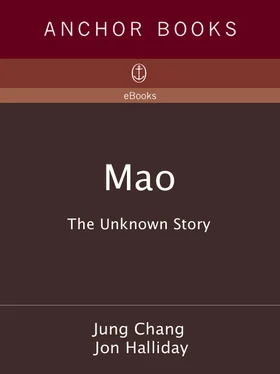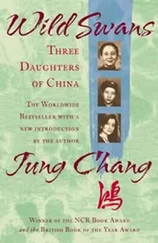For the first time, Mao had to risk his neck. During the arrest scare two years before, he had had time to summon a sedan chair and make off in leisurely fashion to Changsha. But now escape was not so simple. There was no obvious safe haven and the killing of Communists had started. Professor Chen’s eldest son was arrested and beheaded on 4 July. By the end of the year, after the Communists had launched violent uprisings of their own and taken many lives, tens of thousands of Communists and suspects were slaughtered. Anyone could be arrested, and killed, simply on the charge of being a Communist. Many died proclaiming their faith, some shouting slogans, others singing the “Internationale.” Newspapers hailed executions with pitiless headlines.
Mao first had to ensure his personal safety. Then he decided to use the CCP and the Russians for his own ends. This decision, taken in summer 1927, when he was thirty-three, marked Mao’s political coming of age.
PART TWO. LONG MARCH TO SUPREMACY IN THE PARTY
5. HIJACKING A RED FORCE AND TAKING OVER BANDIT LAND (1927–28 AGE 33–34)
AT THE TIME Chiang Kai-shek broke with the Communists in April 1927, Stalin had emerged as the No. 1 in the Kremlin and was personally dictating policy on China. His reaction to Chiang’s split was to order the CCP to form its own army without delay and occupy territory, with the long-term aim of conquering China with the gun.
The military option — the use of force to bring the Chinese Communists to power — had been Moscow’s favored approach ever since the Comintern was founded in 1919. As long as the Nationalists were in play, Moscow’s strategy had been for CCP members to infiltrate and subvert the Nationalist armed forces. Once the break came, Stalin ordered the Communists to pull out those units they were able to control, and “form some new corps.”
Stalin sent a trusted fellow Georgian, Beso Lominadze, to China. Jan Berzin, the head of Russian military intelligence, the GRU, wrote to the commissar for war, Kliment Voroshilov, who chaired the China Commission in Moscow, that Russia’s top priority in China now was to establish a Red army. A huge secret military advice and support system for the Chinese Communists was set up in Russia. The GRU had men in all the main Chinese cities, providing arms, funds and medicine, in addition to intelligence that was often critical to the CCP’s survival. Moscow also sent top-level advisers to China to guide the Party’s military operations, while greatly expanding military training for CCP cadres in Russia.
The immediate plan, devised in Moscow, was for the Communist units pulled out of the Nationalist army to move to the south coast to collect arms shipped in from Russia, and set up a base. At the same time, peasant uprisings were ordered in Hunan and three adjacent provinces where there had been militant peasant organizations, with the goal of taking power in these regions.
Mao agreed with the military approach. On 7 August 1927 he told an emergency Party meeting presided over by Lominadze: “power comes out of the barrel of the gun” (a saying that later acquired international fame). But within this broad design, Mao harbored his own agenda — to command both the gun and the Party. His plan was to build his own army, carve out his own territory, and deal with Moscow and Shanghai from a position of strength. To have his own fiefdom would safeguard his physical survival. He would of course remain in the Party, as its association with Russia was his only chance of achieving anything more than being a mere bandit.
At this time, Professor Chen had just been dismissed as Party chief by Lominadze, and made the scapegoat for the Nationalist split. His replacement was a younger man called Chu Chiu-pai, whose main qualification was his closeness to the Russians. Mao was now promoted, from the Central Committee to the Politburo, though still as a second-level member.
It was now that Mao embarked on a series of steps that would take him to the top of the Communist ladder in the space of four years. As of summer 1927, he had no armed men at his service, and held no military command, so he set out to acquire an armed force by taking over troops that other Communists had built up.
AT THE TIME, the main force the Reds were able to pull out of the Nationalist army consisted of 20,000 troops stationed in and around Nanchang, the capital of Jiangxi province, about 250 km southeast of Wuhan and 300 km east of Changsha. These troops had nothing to do with Mao. On 1 August they mutinied, on Moscow’s instructions. The main organizer of the mutiny was Chou En-lai, the Party man designated to run the military, with immediate supervision from a Russian military adviser, Kumanin. They then headed straight for Swatow (Shantou) on the coast, 600 km to the south, where the Russians were supposed to ship in arms.
Mao set out to lay his hands on some of these men. On their way to the coast they were scheduled to pass near South Hunan. In early August he proposed to the CCP leadership that he launch a peasant uprising in South Hunan, to establish what he called a big Red base, covering “at least five counties.” In fact, Mao had no intention of trying to start such a rising. He had never organized one, nor did he think it could be done. (The earlier peasant violence in Hunan had been carried out under the protection of the then radical government.) The sole purpose of the proposal was to set up his next request, which was for a large contingent of the mutineers to come to his aid on their way to the coast. Failing to realize that this Hunan initiative was only a ruse to angle for the troops, Shanghai approved Mao’s plan.
The leaders of the Hunan “uprising” were scheduled to meet on 15 August at the Russian consulate in Changsha, to launch the action. But Mao did not turn up, although he was on the outskirts of the city. As he was in charge of the mission, the meeting had to be postponed to the following day, when again he failed to show up. He only finally appeared on the 18th, when he moved into the consulate, for the sake of security. To his angry and frustrated comrades, he offered the excuse that he had been conducting “investigations into the peasantry.”
Mao concealed the true reason for his four-day absence — which was to give himself time to see how the mutineers were faring, and whether they would still be passing South Hunan and thus be available to him. If not, he had no intention of going to South Hunan.
The mutineers had got off to a bad start. Within three days of leaving Nanchang, one-third of them had deserted; many others had died drinking dirty water from rice paddies in humid 30-plus centigrade temperatures. The survivors had already lost nearly half their ammunition. The dwindling ranks were struggling just to survive and make it to the coast, and the chances of any making a detour to help him were nil.
So when Mao finally joined his comrades at the Russian consulate, he demanded that the plans for an uprising in South Hunan be canceled, even though it had been his proposal in the first place. Instead, he insisted on attacking just Changsha, the provincial capital, arguing that they should “narrow down the uprising plan.”
The aim of this new plan was exactly the same as before — to lay his hands on some armed men. At this point the only Red forces anywhere near him were outside Changsha. They consisted of three groups: peasant activists with weapons seized from the police; unemployed miners and mine guards from the mine at Anyuan, which had closed down; and one army unit that had been stranded en route to join the Nanchang mutineers. Altogether, the force totaled several thousand. Mao’s point in advocating an attack on Changsha was that these forces would be deployed for action, and he could maneuver to become their boss.
Читать дальше










